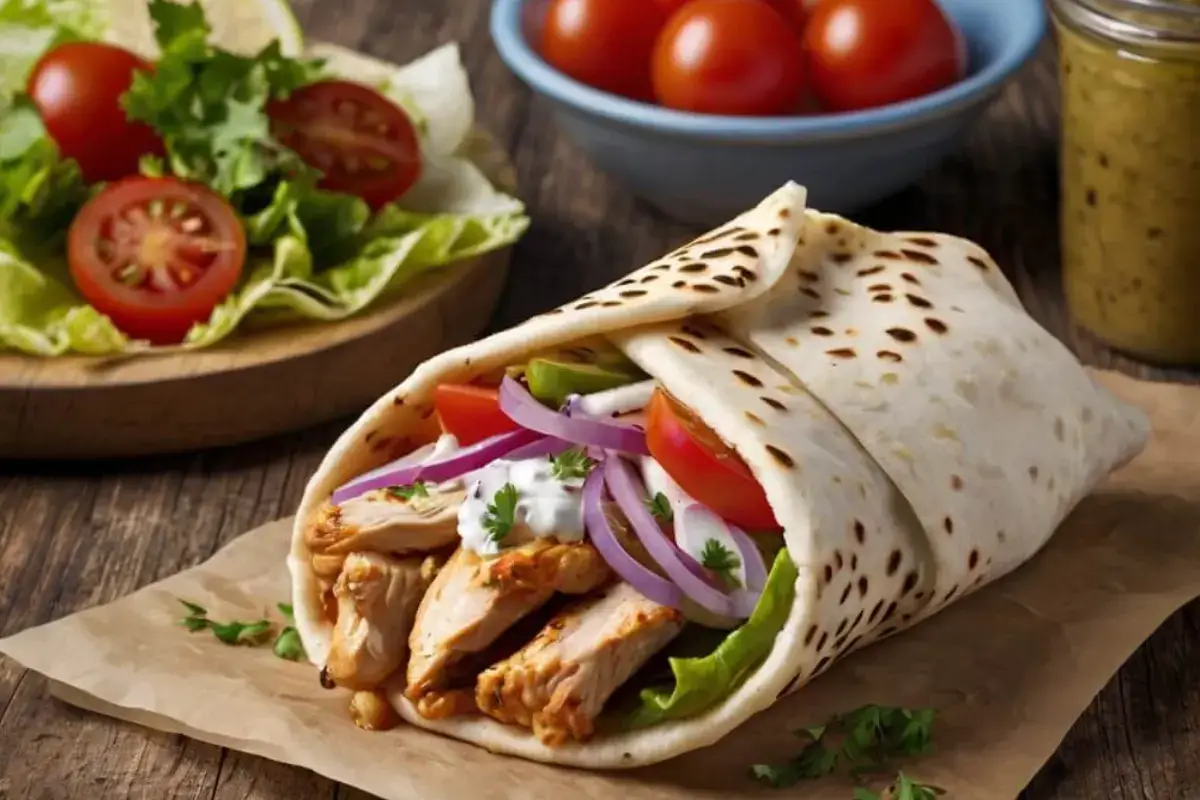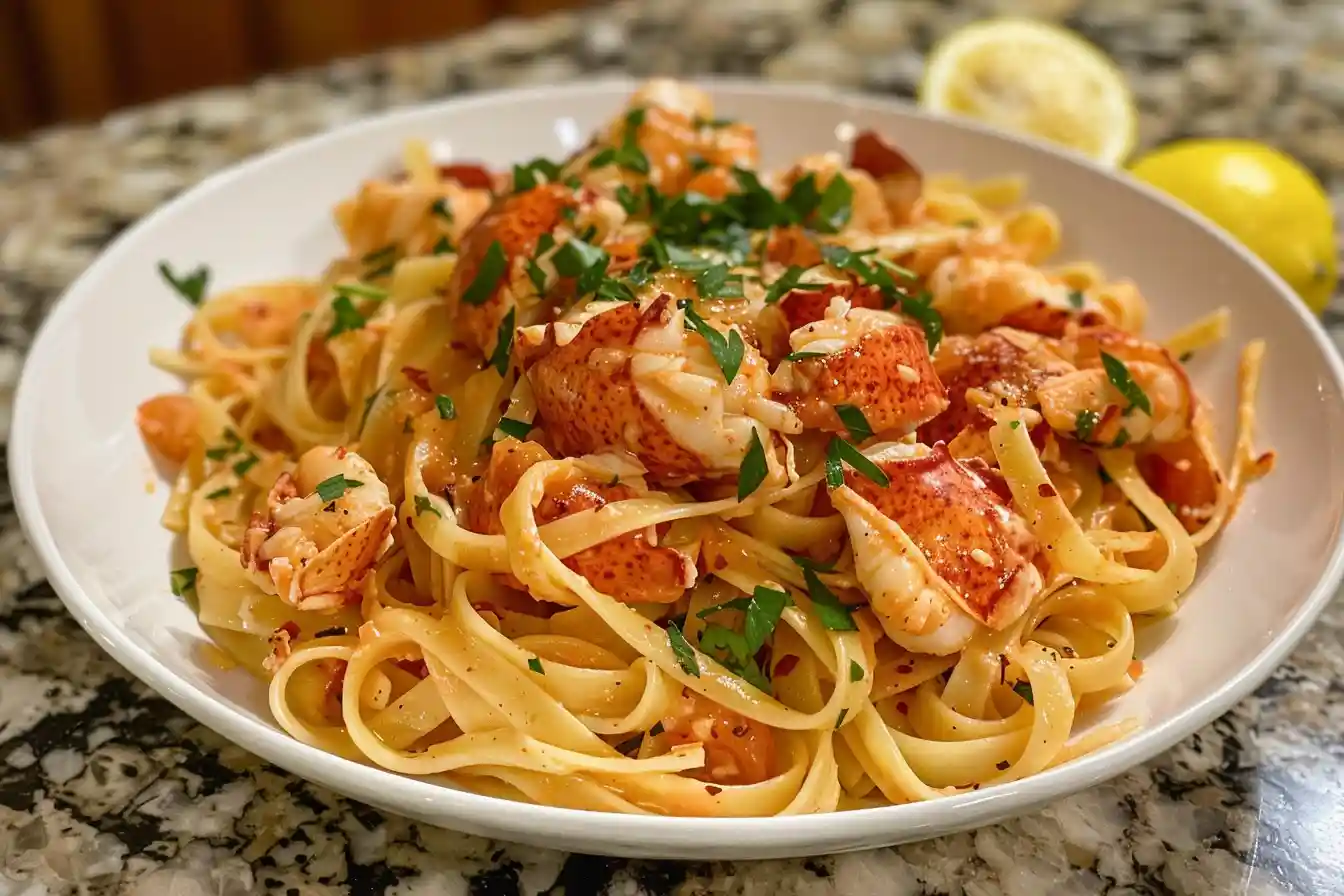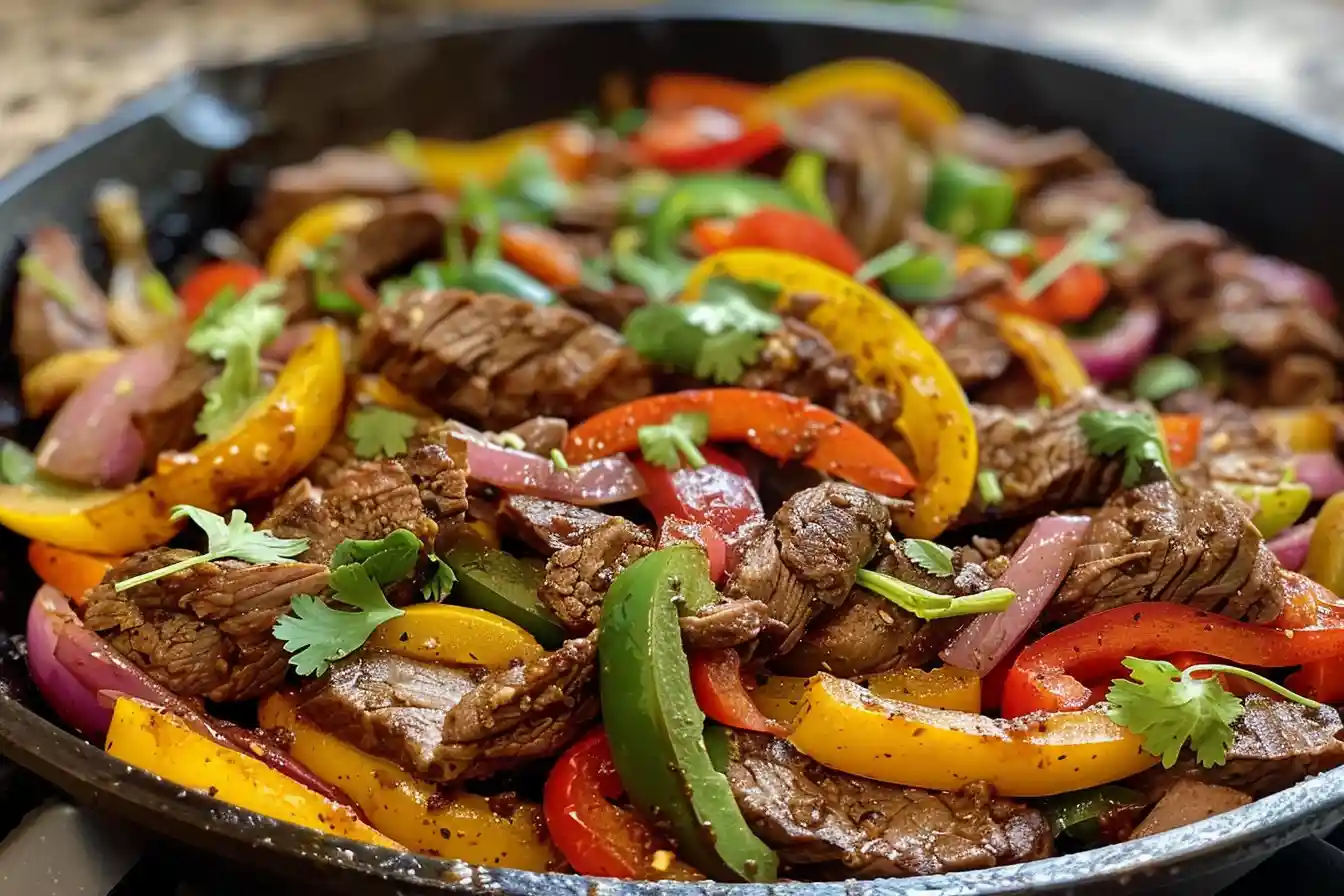Chicken gyro is a beloved dish that has captured the hearts and palates of many around the world. Originating from Greece, chicken gyro is a delightful combination of marinated chicken, spices, vegetables, and sauces, all wrapped up in a warm, soft pita bread.
This article will dive into what chicken gyro is made of?, how to prepare it, and why it’s such a popular choice for food lovers everywhere.
The Origins of Chicken Gyro
Before delving into the ingredients, let’s take a moment to appreciate the history of the gyro. The word “gyro” itself comes from the Greek word “γύρος,” which means “turn” or “revolution.” This refers to the cooking method where the meat is cooked on a vertical rotisserie. Gyros have a long history in Greek cuisine and are a staple in street food culture. Originally, lamb was the meat of choice, but as the dish evolved and spread to different parts of the world, variations like chicken gyro became popular.
The Evolution of Gyros: From Lamb to Chicken
Traditionally, gyros were made with lamb or a combination of lamb and beef. However, as the dish gained popularity outside of Greece, new variations emerged, including the now popular chicken gyro. This version is lighter, often considered healthier, and caters to a wider audience who may prefer poultry over red meat. The shift to chicken as the main protein was also influenced by dietary trends and the availability of ingredients in different regions.
What Is Chicken Gyro Made Of?
Chicken gyro is made from a combination of marinated chicken, pita bread, fresh vegetables, and a variety of sauces, with each component playing a vital role in creating the perfect bite.
1. The Star of the Show: Chicken
The main ingredient in a chicken gyro is, of course, the chicken. Typically, boneless, skinless chicken thighs are used because they remain juicy and flavorful after cooking. The chicken is marinated for several hours, sometimes overnight, in a blend of spices and herbs that infuse it with deep flavor. Key ingredients in the marinade usually include:
- Greek Yogurt: Acts as a tenderizer and adds moisture.
- Olive Oil: Provides richness and helps the chicken brown beautifully.
- Garlic: Essential for that robust, savory flavor.
- Lemon Juice: Adds brightness and helps tenderize the meat.
- Oregano: A quintessential herb in Greek cuisine, offering an earthy flavor.
- Cumin and Coriander: Provide warmth and depth to the flavor profile.
- Paprika: Adds a touch of sweetness and a hint of smokiness.
2. The Perfect Vessel: Pita Bread
No chicken gyro is complete without a warm, soft pita to hold all the delicious components together. Pita bread is a staple in Mediterranean cuisine and serves as the ideal wrapper for gyros. It’s important that the pita is soft yet sturdy enough to hold the filling without tearing. Traditional pita bread is made from simple ingredients like flour, water, yeast, and salt, and is often baked until it puffs up into a pocket, which can then be filled or used as a wrap.
3. Fresh Vegetables for Crunch and Color
A chicken gyro is not just about the meat; the vegetables play a crucial role in providing texture and freshness. Common vegetables found in a chicken gyro include:
- Tomatoes: Juicy and sweet, they add a necessary contrast to the savory chicken.
- Onions: Usually sliced thin and often pickled, they add a sharp bite.
- Cucumbers: Cool and crisp, they provide a refreshing crunch.
- Lettuce: Adds another layer of crunch and a bit of bitterness.
4. Creamy and Tangy Sauces
One of the defining features of a chicken gyro is the sauce. The most traditional sauce is tzatziki, a creamy, tangy concoction made from Greek yogurt, cucumbers, garlic, and lemon juice. It complements the seasoned chicken perfectly and adds a cooling element to the dish. Some variations may also include garlic sauce or a light drizzle of olive oil.
5. Additional Toppings
While the essentials of a chicken gyro are the marinated chicken, pita bread, fresh vegetables, and sauce, you can also add extra toppings to enhance the flavor and texture. Some popular additions include:
- Feta Cheese: Adds a salty, tangy flavor that complements the other ingredients.
- Olives: Brings a briny, rich flavor, typically with kalamata olives.
- Chili Flakes: For those who like a bit of heat.
- Pickled Vegetables: Adds an extra tang and crunch, such as pickled red onions or jalapeños.
The Marination Process: Unlocking Flavor
The marination process is a crucial step in making a delicious chicken gyro. Marinating the chicken not only infuses it with flavor but also tenderizes the meat, ensuring that it remains juicy after cooking.
Why Marinate?
Marinating the chicken in a blend of yogurt, lemon juice, olive oil, and spices allows the flavors to penetrate deep into the meat. The acidity from the lemon juice and yogurt helps to break down the proteins in the chicken, making it more tender. Meanwhile, the oil and spices cling to the chicken, creating a flavorful crust when it’s cooked.
How Long Should You Marinate?
For the best results, marinate the chicken for at least 2 hours, but overnight is preferable. This extended marination time allows the flavors to fully develop, resulting in a more flavorful and tender chicken. If you’re short on time, even a 30-minute marination can still make a noticeable difference, but the longer, the better.
Cooking Methods: Bringing Chicken Gyro to Life
Once the chicken is marinated, it’s time to cook it. While traditional gyros are cooked on a vertical rotisserie, most home cooks don’t have access to this equipment. However, there are several other methods you can use to achieve similar results.
1. Grilling
Grilling is one of the best ways to cook marinated chicken for gyros. The high heat of the grill sears the chicken, creating a flavorful, slightly charred exterior while keeping the inside juicy. To grill the chicken, preheat your grill to medium-high heat. Place the chicken on the grill and cook for about 6-8 minutes on each side, or until the internal temperature reaches 165°F (74°C).
2. Oven Roasting
If you don’t have a grill, oven roasting is an excellent alternative. Preheat your oven to 400°F (200°C). Place the marinated chicken on a baking sheet lined with foil or parchment paper. Roast for 25-30 minutes, flipping halfway through, until the chicken is cooked through and has developed a nice caramelized color.
3. Pan-Searing
For those who prefer cooking indoors, pan-searing is a quick and effective method. Heat a large skillet over medium-high heat and add a bit of oil. Once the oil is hot, add the chicken and cook for about 5-7 minutes per side, until the chicken is cooked through and has a golden-brown crust.
4. Using a Rotisserie
If you have access to a rotisserie, this is the traditional way to cook gyros. The chicken is stacked on the rotisserie spit and cooked slowly, rotating to ensure even cooking. This method results in incredibly juicy and flavorful meat, with the outer layers developing a deliciously crispy texture.
Assembling the Perfect Chicken Gyro
Now that the chicken is cooked, it’s time to assemble the chicken gyro. This is where all the individual components come together to create a delicious and satisfying meal.
1. Preparing the Pita
Start by warming the pita bread. You can do this on the grill, in the oven, or even in a skillet on the stovetop. Warming the pita makes it more pliable and enhances its flavor.
2. Adding the Chicken
Next, slice the cooked chicken into thin strips. Place a generous portion of chicken in the center of the warmed pita.
3. Layering the Vegetables
Add your chosen vegetables on top of the chicken. Traditional options include sliced tomatoes, onions, and cucumbers. You can also add lettuce for extra crunch.
4. Drizzling the Sauce
The final touch is the sauce. Tzatziki is the classic choice, but you can also experiment with other sauces like garlic sauce or a spicy yogurt sauce. Drizzle the sauce generously over the chicken and vegetables.
5. Wrapping It Up
Fold the pita around the filling to create a wrap. If you like, you can secure it with a piece of parchment paper or foil to help keep everything in place.

What to Serve with Chicken Gyro
Chicken gyro is a complete meal on its own, but there are several side dishes and accompaniments that can elevate your dining experience.
1. Greek Salad
A classic Greek salad is a perfect side dish for chicken gyro. Made with fresh cucumbers, tomatoes, red onions, kalamata olives, and feta cheese, it’s dressed in a simple olive oil and lemon vinaigrette. The salad’s light and refreshing qualities complement the richness of the gyro.
2. French Fries
In Greece, it’s common to serve gyros with a side of French fries, or even to tuck a few fries directly into the gyro itself. The crispiness of the fries contrasts nicely with the tender chicken and soft pita.
3. Rice Pilaf
Rice pilaf, flavored with herbs and spices, makes for a satisfying and comforting side dish. It’s an excellent choice if you’re serving chicken gyro as part of a larger meal.
4. Hummus and Pita Chips
For a lighter option, serve your chicken gyro with hummus and pita chips. The creamy hummus is a great dip for the pita chips and adds another layer of flavor to your meal.
5. Tabbouleh
Tabbouleh is a fresh and vibrant salad made from bulgur wheat, parsley, tomatoes, mint, and lemon juice. Its bright flavors pair well with the savory chicken gyro, adding a refreshing contrast to the meal.
Health Benefits of Chicken Gyro
While chicken gyro is undeniably delicious, it’s also worth noting that it can be a relatively healthy meal, especially compared to other fast-food options.
1. High in Protein
Chicken is a great source of lean protein, which is essential for muscle growth and repair. A typical chicken gyro provides a good amount of protein, making it a satisfying and nourishing option.
2. Rich in Vitamins and Minerals
The fresh vegetables in a chicken gyro contribute important vitamins and minerals to your diet. For example, tomatoes are rich in vitamin C and potassium, while cucumbers provide hydration and a small amount of fiber.
3. Yogurt Benefits
The tzatziki sauce, made with Greek yogurt, adds probiotics to your meal, which are beneficial for gut health. Greek yogurt is also high in protein and calcium.
4. Healthy Fats
The use of olive oil in the marinade and tzatziki sauce provides healthy monounsaturated fats, which are good for heart health.
5. Low Carb Option
For those following a low-carb diet, you can enjoy the chicken and vegetables without the pita, or opt for a low-carb pita or lettuce wrap instead.
Chicken Gyro Variations: Exploring New Flavors
While the classic chicken gyro is hard to beat, there are several variations you can try to mix things up.
1. Spicy Chicken Gyro
For those who enjoy a bit of heat, consider making a spicy version of the chicken gyro. Add cayenne pepper or red chili flakes to the marinade, and serve the gyro with a spicy sauce, such as a sriracha yogurt sauce.
2. Mediterranean Chicken Gyro
Enhance the Mediterranean flavors by adding ingredients like sun-dried tomatoes, roasted red peppers, and artichokes. You can also mix some feta cheese into the tzatziki sauce for extra tanginess.
3. BBQ Chicken Gyro
For a unique twist, try a BBQ chicken gyro. Marinate the chicken in your favorite BBQ sauce instead of the traditional Greek marinade, and pair it with coleslaw and pickles for a Southern-inspired gyro.
4. Greek-American Fusion Gyro
Combine Greek and American flavors by adding crispy bacon, avocado, and a drizzle of ranch dressing to your chicken gyro. This fusion version is rich and indulgent, perfect for a hearty meal.
5. Vegetarian “Chicken” Gyro
For a vegetarian option, replace the chicken with grilled tofu or tempeh. Marinate the tofu or tempeh in the same spices and yogurt mixture, and cook it until it’s golden brown and flavorful. This variation maintains the essence of a gyro while catering to a plant-based diet.
A Cultural and Culinary Icon
More than just a meal, chicken gyro represents a piece of Greek culture that has been embraced by people all over the world. It’s a dish that brings people together, whether you’re grabbing a quick bite on the go or enjoying a leisurely meal with friends and family. The skills learned in making a chicken gyro—from marinating meat to assembling the wrap—are valuable in many other culinary endeavors, making this dish not only delicious but also a great way to hone your cooking skills.
Final Thoughts
So, the next time you’re wondering, “What is chicken gyro made of?” remember that it’s more than just the sum of its parts. It’s a dish that embodies the essence of Mediterranean cuisine, combining fresh, healthy ingredients with bold, savory flavors. Whether you stick to the classic recipe or try out a creative variation, making and enjoying chicken gyro is sure to be a rewarding experience.
In conclusion, a chicken gyro is a harmonious blend of flavors and textures, making it a favorite dish for many. From the tender, marinated chicken to the crisp vegetables and creamy tzatziki, every component plays a crucial role in creating a delicious and satisfying meal.
Whether you’re enjoying a traditional version or experimenting with new flavors, the versatility of the chicken gyro makes it a dish that can be enjoyed in countless ways.





